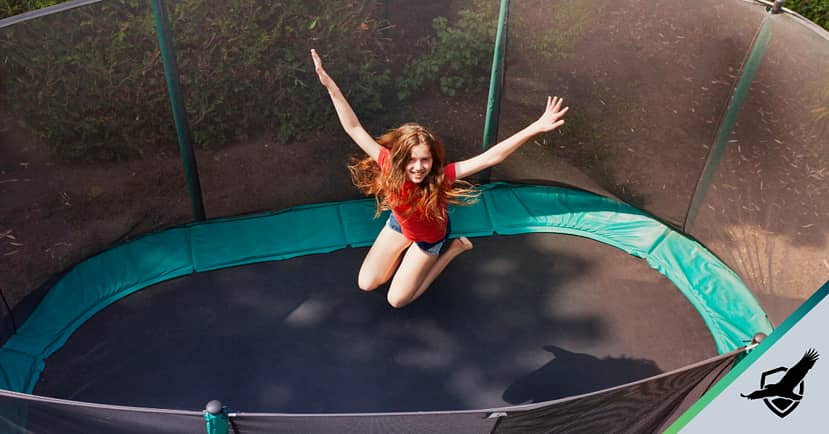Top 10 Trampoline Risks and Hazards: How to Spring Toward Safety

Trampolines are fantastic fun for the kids. The downside: they could cause injuries and emergency room trips.
The American Association of Pediatrics (AAP) and American Association of Orthopaedic Surgeons (AAOS) discourage trampoline use due to the risk of bruises, sprains, spinal cord damage, and bone breaks. If you want to put a number to it, there were 300,000 medically treated trampoline injuries in 2018.
There’s just one problem. If you take down your trampoline, your kids could melt down.
Is there a middle ground? Learn the top 10 trampoline risks and hazards to spring your family toward safety.
How to Handle the Top 10 Trampoline Risks
It’s healthy for kids to run and play. But what makes trampolines more dangerous than soccer, baseball, and other outdoor activities?
If you’ve ridden a bike, you’ve probably scraped your knee. Trampolines, on the other hand, could send you into hard ground or catch your ankle in a spring.
Here are ten ways to help your kids avoid common trampoline risks
1. Bounce One at a Time
Multiple bouncers can bump into one another or knock a smaller child into the springs or onto the ground. One at time may be tough, but it’s worth the wait.
2. Save the Flips
It’s hard to control your momentum if you aren’t used to jumping. Misjudging the spin on a flip can cause you to land in an awkward position.
That’s a good reason to ban flips on your family’s trampoline.
3. Supervise, Supervise, Supervise
Children of all ages need supervision. They find it impossible to resist the lure of jumping. So grab an iced tea, set up a lawn chair, and spend some quality time watching your kids have fun.
4. No Kids Under Six Allowed
Stanford Children’s Health says kids under the age of six are at greater risk for trampoline injuries such as broken bones, concussions, and sprains. Knowing this, you might want to keep the younger kids off the trampoline. Or, make sure they only jump under the closest supervision.
5. Use Safety Nets
A safety net around a trampoline can limit the chances of flying off and landing on the ground. The net won’t keep you from landing on the frame or springs of the trampoline, both of which can cause significant injuries.
6. Check the Springs
Speaking of springs, be sure to check them regularly. Springs get rusty, wear out, and break or come unhooked. Any of these situations can lead to an unsafe trampoline.
7. Cover the Springs
You can reduce the risk of injury by covering your trampoline springs and frame with safety pads. These pads wear out quickly, so replace them when they start breaking down.
8. Jump in the Center
Teach your kids to stay in the center of the trampoline when they jump. Staying closer to the center keeps them away from the edge, where they could accidentally bounce off the trampoline.
9. Stay Away From Trees
Stay away from trees, lampposts, flagpoles, and structures that could cause injuries if your child jumps into them.
10. Keep It Clear
Don’t store anything under the trampoline, and don’t let kids play underneath it when someone is using it.
What About Trampoline Parks?
At this point, you might want to avoid the risks of trampoline ownership. Even if you get an earful from the little ones.
What about trampoline parks? As it turns out, they can be more dangerous than owning a trampoline.
Let’s say the kids bug you until you find a trampoline park, Bouncy Bob’s Wacky Jump Zone. It’s only 15 minutes away!
This looks like the perfect alternative, but …
According to AAOS, injuries sustained at trampoline parks are generally more severe than injuries from trampolines at home.
You can’t enforce the rules yourself, but you can check to see if a trampoline park takes safety seriously.
SafeBee says trampoline parks should have these precautions in place:
No kids under six should be allowed to jump.Posted rules forbid loose clothes, multiple bouncers per trampoline, and roughhousing.Safe bouncing instructions for each jumper.Trampoline springs should be covered.
Call or message the trampoline park to discuss the rules before you take your kids.
Talk to Your Agent About Trampolines
We’ll go one step farther. If you rent your home, talk to your landlord before you put up a trampoline.
A lot of landlords don’t like trampolines because insurance companies classify them as an “attractive nuisance.” An attractive nuisance is a potentially dangerous feature of a property that attracts children.
Here’s what that really means (minus the insurance jargon). The neighbor boy could sneak out of the house next door and jump on your trampoline. If he gets hurt, his parents could sue you and the landlord.
This same scenario could play out if you own your home. Even if you have no landlord, you want to work with your insurance agent to follow the trampoline guidelines laid out in your homeowners insurance policy.
The Umbrella Gives You Extra Protection
Personal umbrella coverage activates after you’ve exceeded the limits of other policies. Umbrella policies help protect your assets and future earnings from being lost in a lawsuit.
Plus, the coverage is incredibly affordable! It makes perfect sense to let an umbrella policy protect you when you have a trampoline.
What’s your next step? Hop on over to your local Pekin Insurance agency.
Your Pekin Insurance agent will help you set up a personal umbrella policy that fits your needs and budget.



